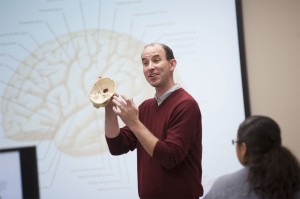Molding the next generation of scientists

Researchers at the Texas A&M Health Science Center College of Medicine make sharing their passion for science a top priority. Through several recurring mentorship programs, faculty pour their energy into helping middle and high school students explore science careers, ultimately shaping the next generation of research scientists.
Each November, the college hosts high school students for half-day programs that offer hands-on experience with human anatomy, including a short lesson on memory and brain-based studying tips, a tour of the health science center’s state-of-the-art Clinical Learning Resource Center – where students gear up in scrubs and participate in simulated activities with manikins – and interaction with and lectures by faculty members.

In one session, students visit the anatomy lab of assistant professor Gregg Allen, Ph.D., where they are able to view a human brain from the college’s Willed Body Program.
“[That was] my favorite part about the lab … even though I was about to pass out,” said Ariel Gholson, a previous attendee from Hammond-Oliver High School for the Human Sciences. “I don’t think this is something I would have had the chance to do at any other school.
What students learn while at the clinic is not only integrated in their biology and anatomy classes when they return to school, but may serve them in the future as well. Planning for college and a career in health care, while still in high school, is an important stepping-stone for their future educational journey.
Although the program is coordinated by the college’s Office of Institutional Advancement, it takes a significant commitment from faculty to prepare for, and then host, sessions for the students over the course of a day. So what motivates the involvement of faculty who have medical school students to train and research to conduct?
“Honestly, a change of pace is one of the best parts about teaching high school students,” Allen said. “It’s remarkable to have conversations with these students. The depth and understanding they have of biological principles at this stage of their education is admirable.”

Some faculty members’ passion for outreach leads them to take on even greater challenges – outside the normal Monday through Friday gig. Associate professor Andreea Trache’s Saturday Morning Biophysics program, now in its sixth year, is a case in point. Designed for middle school and high school girls in Bryan-College Station and surrounding communities, Trache has built a network of faculty, students, school administrators and community groups who join forces to deliver a quality program.
The program was created as part of the educational initiative of the National Science Foundation Career Award Trache received in 2008, which provides funding each fall. The girls in attendance are not required to pay.
“The main goal of the program is to encourage women into science, by stimulating interest among middle and high school girls and minority students, in biophysics as well as science in general,” Trache said.
This past September through November, 55 girls from 19 schools across the Brazos Valley attended the program on five Saturdays for three hours each morning. Students are split into groups and rotate to different demonstrations, experiments and speakers, work with equipment that they would not normally have a chance to operate, and participate in many hands-on activities, including cutting lenses out of Jell-O and laser pointers to demonstrate basic optics concepts.
Sessions are led by faculty and graduate students from Texas A&M colleges and programs, including: the College of Medicine, College of Veterinary Medicine, College of Science, Department of Biomedical Engineering and Department of Visualization. Texas A&M students, often first-generation college students or first-generation doctoral candidates, speak to the middle and high school students about their path to college or graduate school; while faculty members lecture about their specific areas of research interest.
“I think this program is important because it allows the students to learn and experience science in a fun, supportive and less formal environment than the classroom, so they can be more engaged and less constrained than they might be in a school situation,” said Van Wilson, Ph.D., a professor in the Texas A&M College of Medicine Department of Microbial and Molecular Pathogenesis. “It also provides them with the opportunity to interact with practicing scientists. I think it’s important they see that scientists are real, ‘normal’ people just like them and that they could become scientists if they want.”

The Girl Scouts have also supported the program for the past several years, offering assistance in transportation for the girls from rural communities and helping to provide meals, as well as the Department of Medical Physiology.
“Many of the girls who attend are from smaller towns like Caldwell and Somerville,” Trache said. “Without the Girl Scouts providing transportation for them, they would not have been able to attend.”
Each year, attendance of the program has increased—a testament to Trache’s dedication to networking in schools to recruit students for the program.
“I am looking forward to see the program grow in number of students attending, as well as diversifying the activities we will offer, especially the hands-on activities,” she said. “Reaching out to the girls who are interested is key.”
Media contact: media@tamu.edu


